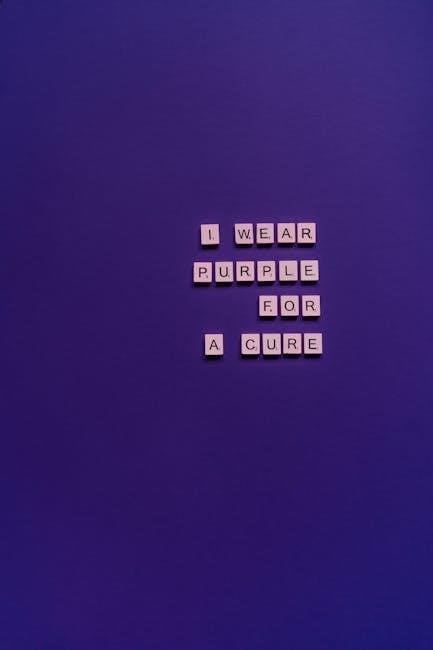They Say / I Say by Gerald Graff and Cathy Birkenstein is a widely acclaimed guide to academic writing. It introduces essential templates and strategies for engaging with sources, helping writers present arguments clearly and effectively. The book emphasizes the importance of understanding and responding to others’ ideas, making it a valuable resource for students and educators alike. Its practical approach to structuring academic discourse has made it a popular choice for improving writing skills and fostering critical thinking.
Overview of the Book
They Say / I Say by Gerald Graff and Cathy Birkenstein is a practical guide to academic writing that focuses on templates and strategies for engaging with sources. The book emphasizes the importance of understanding and responding to others’ ideas, providing readers with tools to structure arguments effectively. With a focus on clarity and conciseness, it offers templates for introducing and responding to viewpoints, making it accessible to students and educators alike. The fourth edition includes updated examples and exercises, enhancing its value for learners at all levels.
Authors: Gerald Graff and Cathy Birkenstein
Gerald Graff and Cathy Birkenstein are renowned educators and writers, both affiliated with the University of Illinois at Chicago. Graff, a literary critic and educator, specializes in academic writing and critical thinking. Birkenstein brings expertise in composition and rhetoric. Together, they co-authored They Say / I Say, aiming to demystify academic writing by providing practical templates and strategies. Their collaboration has made the book a cornerstone for students and educators, offering accessible tools to engage with complex ideas and construct persuasive arguments effectively.
Purpose of the Book
The primary purpose of They Say / I Say is to demystify academic writing by providing practical tools for engaging with sources and structuring arguments. The book offers templates and language frameworks that help writers present their ideas clearly and respond to opposing viewpoints. By emphasizing the importance of understanding others’ perspectives, Graff and Birkenstein aim to empower writers to participate confidently in academic and intellectual discussions. The book’s goal is to make academic writing more accessible and less intimidating for students and professionals alike.

Key Concepts in “They Say / I Say”
They Say / I Say introduces key concepts like academic templates, transitions, and the importance of addressing counterarguments. These tools help writers engage effectively with sources and structure their arguments clearly, fostering a deeper understanding of academic discourse.
The Idea of “Templates” in Academic Writing
The book introduces templates as essential tools for academic writing. These templates provide structured formats for expressing ideas, responding to sources, and framing arguments. By using phrases like “They say… I say…” or “So what? Who cares?”, writers can engage effectively with existing ideas and present their own perspectives clearly. These templates are designed to be flexible, allowing writers to adapt them to various contexts while maintaining clarity and coherence in their arguments.
Transitions and Moves in Academic Discourse

The book emphasizes the importance of transitions and moves in structuring academic arguments. It provides templates like “They say… I say…” and “So what? Who cares?” to help writers connect ideas smoothly. These phrases act as bridges between different parts of an argument, guiding the reader through the writer’s logic. By mastering these transitional moves, writers can effectively present their viewpoints, address counterarguments, and maintain the flow of their discourse. This approach enhances clarity and persuasiveness in academic writing.
Importance of Addressing Counterarguments
Gerald Graff and Cathy Birkenstein stress the importance of addressing counterarguments in academic writing. By acknowledging opposing viewpoints, writers strengthen their own arguments and demonstrate a deeper understanding of the topic. The book provides templates like “They say.;. I say…” to help writers incorporate counterarguments effectively. This approach encourages critical thinking and fosters a balanced, nuanced discussion. Addressing counterarguments also shows respect for diverse perspectives, enhancing the credibility and persuasiveness of the writer’s position; This strategy is essential for constructing robust academic discourse.

Structure of the Book
They Say / I Say is organized into clear chapters, each focusing on specific aspects of academic writing. The book uses real-world readings and practical exercises to illustrate key concepts, making it accessible and engaging for learners. This structured approach helps writers build confidence and mastery in expressing their ideas effectively.
Chapters and Their Focus Areas
They Say / I Say is divided into chapters that systematically introduce key concepts in academic writing. Early chapters focus on templates for engaging with sources, while later sections explore advanced strategies like addressing counterarguments and using transitions effectively. Each chapter includes practical exercises and real-world examples to reinforce learning. The book’s structure ensures a progressive mastery of skills, making it accessible to writers at all levels. This clear organization helps readers build a solid foundation in academic discourse and critical thinking.
Use of Readings and Examples
They Say / I Say enriches its instruction with diverse readings and examples, drawn from various academic fields. These selections illustrate how templates and rhetorical moves are applied in real writing scenarios. By including both contemporary and historical texts, the book demonstrates the universality of academic writing strategies. The examples are carefully chosen to engage students and help them see how theories translate into practice, making complex concepts more accessible and relatable for learners at all levels.
Practical Exercises for Writers
They Say / I Say provides numerous practical exercises designed to help writers apply the book’s principles. These exercises guide students through the process of identifying templates, practicing rhetorical moves, and crafting clear arguments. By engaging with these exercises, writers can improve their ability to engage with sources and present their ideas effectively. The exercises are structured to be both challenging and accessible, making them an invaluable tool for developing strong academic writing skills and confidence in expressing one’s own voice.
Editions of “They Say / I Say”
They Say / I Say is available in multiple editions, with the fourth edition being the most recent. It includes updated templates, examples, and exercises to enhance learning and adapt to modern academic writing needs. The book’s structure and content have evolved over editions, ensuring relevance for both students and educators. This edition remains a popular choice for improving writing skills and understanding academic discourse.
Different Editions and Their Updates
They Say / I Say has been published in multiple editions, with each version offering updated content and improved features. The fourth edition includes new templates, expanded examples, and additional exercises to enhance the learning experience. Earlier editions introduced foundational concepts, while later updates refined these ideas to better align with contemporary academic writing practices. The revisions reflect the authors’ commitment to providing practical tools for writers, ensuring the book remains a timeless resource for improving argumentative writing skills and fostering critical thinking.
Relevance of the Fourth Edition
The fourth edition of They Say / I Say remains highly relevant, offering updated templates and real-world examples that cater to modern academic demands. It includes new chapters on digital writing and multimedia sources, making it adaptable to evolving communication platforms. The edition also expands on strategies for addressing counterarguments, enhancing the depth of critical thinking. These updates ensure the book stays a leading resource for students and educators seeking to master the nuances of persuasive and analytical writing in today’s diverse academic landscape.

Impact and Reception
They Say / I Say has become a highly influential and widely adopted textbook, sparking debates about its approach to teaching academic writing. Its popularity endures, shaping discourse.
Popularity Among Students and Educators
They Say / I Say has gained immense popularity due to its accessible approach to academic writing. Students appreciate its practical templates and clear guidance, while educators praise its ability to demystify complex writing strategies. The book’s engaging tone and real-world examples make it a favorite in universities worldwide. Its adoption across various curriculums underscores its effectiveness in helping writers of all levels develop confidence and clarity in their work.
Critical Debates About the Book
Despite its popularity, They Say / I Say has sparked debates about its approach. Critics argue that its reliance on templates may oversimplify complex writing processes, potentially limiting creativity. Some educators worry that the book’s structured formulas could hinder students from developing their unique voices. However, supporters counter that these templates provide a necessary foundation for new writers, helping them navigate academic discourse more effectively. The book’s impact remains a subject of lively discussion in academic circles, reflecting broader debates about writing instruction.

Target Audience
They Say / I Say is designed for students, educators, and anyone seeking to improve academic writing skills. It serves as a practical guide for both novices and professionals.
Who Can Benefit from the Book?
They Say / I Say is ideal for students at all academic levels, from high school to graduate studies, as well as educators seeking to teach academic writing effectively. Professionals looking to enhance their writing skills will also find it beneficial. The book’s practical templates and strategies make it accessible to both novice and experienced writers, helping them engage with complex ideas and structure their arguments clearly. Its universal appeal lies in its ability to demystify academic writing, making it a valuable tool for anyone aiming to improve their communication skills and critical thinking abilities.
Use in Academic and Professional Settings
They Say / I Say is widely used in academic settings to teach students how to engage with sources and structure arguments effectively. Its templates and strategies are invaluable for writing academic papers, as they help students present their ideas clearly and respond to opposing viewpoints. In professional settings, the book’s techniques for articulating arguments and addressing counterarguments are equally beneficial, making it a versatile tool for improving communication and critical thinking skills across various disciplines and industries.

Reviews and Testimonials
They Say / I Say has received widespread acclaim for its practical approach to academic writing. Educators and students praise its templates and strategies for fostering critical thinking and clear argumentation, making it a go-to resource for improving writing skills at all levels.
What Experts Say About the Book
Experts widely commend They Say / I Say for its innovative approach to teaching academic writing. Gerald Graff and Cathy Birkenstein’s use of templates and real-world examples has been praised for making complex concepts accessible. Educators highlight its effectiveness in helping students engage with sources and articulate their arguments. The book’s ability to bridge the gap between theory and practice has solidified its reputation as a cornerstone of writing education. Its structured yet flexible approach has made it a favorite among instructors and students alike, fostering critical thinking and clear communication in academic settings. The templates provided are particularly valued for guiding writers through the process of responding to opposing viewpoints, a crucial skill in scholarly discourse. Overall, the book is celebrated for its transformative impact on how students and educators approach academic writing, ensuring that it remains a vital tool for years to come.
Student Feedback and Experiences
Students widely praise They Say / I Say for its practical and accessible approach to academic writing. Many report that the book’s templates and strategies have helped them confidently engage with complex sources and articulate their ideas more effectively. The clear structure and real-world examples make it easier for students to understand and apply key concepts. By emphasizing the importance of addressing counterarguments, the book has empowered students to write more persuasively and participate actively in academic discussions. Overall, students appreciate how the book demystifies the writing process, making it an invaluable tool for academic success.
Additional Resources and Supplements
The book is supported by online resources, including guides and teaching materials, to enhance understanding and application of its concepts. These supplements aid both students and educators in mastering academic writing techniques effectively.
Online Resources and Guides
The book is complemented by online resources, including interactive guides and downloadable templates, to help users master its writing strategies. These tools provide practical exercises, examples, and tips for effectively using the “they say/I say” approach. Educators can access supplementary materials, such as lesson plans and presentation slides, to integrate the book into their curriculum. Additionally, the fourth edition offers updated resources to reflect modern academic writing challenges, ensuring relevance and adaptability for both students and instructors.
Teaching Materials for Instructors
Instructors can access a range of teaching materials to support the use of They Say / I Say in the classroom. These include instructor’s manuals, lesson plans, and presentation slides that align with the book’s chapters and key concepts. The fourth edition offers updated resources, such as additional exercises and discussion prompts, to help educators effectively teach academic writing strategies. These materials are designed to enhance student engagement and understanding, providing educators with flexible tools to adapt the content to various teaching styles and student needs.

Challenges and Limitations
While They Say / I Say is widely praised, some critics argue it oversimplifies academic writing processes and may limit creativity by relying too heavily on templates.
Criticisms of the Book’s Approach
Some critics argue that They Say / I Say oversimplifies academic writing by relying too heavily on templates, potentially limiting creativity and critical thinking. While the book provides structured frameworks for engaging with sources, critics suggest it may discourage writers from developing their unique voice and exploring more nuanced arguments. Additionally, the emphasis on predetermined templates could hinder the ability to adapt to diverse writing contexts and genres. These critiques highlight the tension between structure and flexibility in academic writing instruction.
Balancing Structure and Creativity
They Say / I Say provides structured templates to guide writers, but some argue this approach may stifle creativity. While the book offers essential frameworks for organizing ideas, critics suggest that over-reliance on templates could limit the development of unique writing styles. However, the authors emphasize that these structures are meant to be flexible, allowing writers to adapt them to their voice and context. By balancing structure with personal expression, the book encourages writers to think critically while maintaining clarity and coherence in their arguments. This balance is key to its enduring popularity.
They Say / I Say is a transformative guide that empowers writers with practical tools for academic discourse. Its structured approach and emphasis on countering perspectives make it invaluable for learners and professionals alike, fostering clear and persuasive communication in various settings.
Final Thoughts on the Book’s Value
They Say / I Say stands as a cornerstone for mastering academic writing, offering timeless strategies for engaging with ideas. Its templates and emphasis on addressing counterarguments empower writers to express themselves confidently and critically. By bridging gaps between personal opinions and scholarly discourse, the book fosters intellectual conversations. Its accessibility makes it a vital tool for students, scholars, and professionals, ensuring its enduring relevance in diverse fields. This guide not only teaches writing but also prepares readers to navigate complex intellectual landscapes with clarity and precision.
Recommendations for Future Readers
Future readers of They Say / I Say will benefit from its practical templates and strategies for engaging with academic discourse. The book’s focus on addressing counterarguments and using transitions enhances clarity and persuasion in writing. Readers are encouraged to embrace the book’s tools to articulate their ideas more effectively. Whether for academic or professional purposes, this guide equips writers with the skills to navigate complex intellectual discussions. Its accessible approach makes it an invaluable resource for anyone aiming to improve their writing and critical thinking abilities in a structured and impactful way.
Further Reading and Resources
For deeper exploration, readers can explore other works by Gerald Graff and Cathy Birkenstein, including additional guides on academic writing and critical thinking. Supplementary materials, such as online tutorials and writing workshops, offer practical exercises to enhance skills. The book’s official website provides updated resources, while scholarly articles and reviews offer further insights into its methodologies and applications. These resources collectively support a comprehensive understanding of academic discourse and effective writing strategies.
Related Books on Academic Writing
Readers interested in academic writing may explore works like The Elements of Style by William Strunk Jr. and E.B. White, or A Writer’s Reference by Diana Hacker. These texts, like They Say / I Say, focus on improving writing clarity and argumentation. Additionally, The Craft of Research by Booth, Colomb, and Williams offers practical advice on research-based writing. Gerald Graff’s Clueless in Academe and Cathy Birkenstein’s other writings also provide valuable insights into academic discourse. These resources collectively enhance writing skills and critical thinking.
References for Advanced Study
For advanced study, readers can explore academic journals like College Composition and Communication or College English, which offer in-depth analyses of writing strategies. Online databases such as JSTOR or MLA International Bibliography provide access to scholarly articles on academic discourse. Additionally, works like The Rhetoric of Textual Authority by Gerald Graff and studies on rhetorical theory can deepen understanding. These resources enable readers to engage with complex ideas and stay updated on the latest trends in academic writing and critical thinking.



